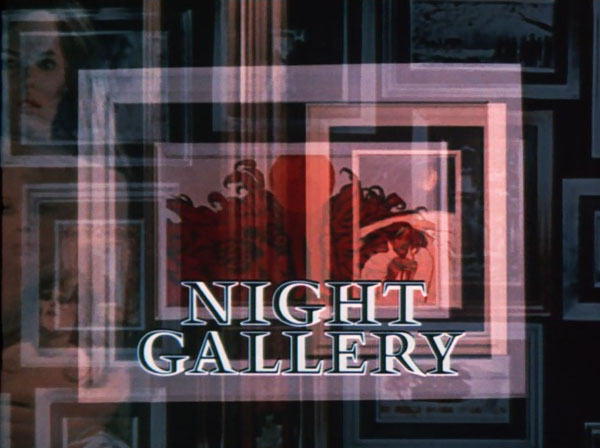Serling Recedes, Spectres Abound, Stories Wind Down In The Third Wing Of The Gallery
DIRECTED BY: JOHN BADHAM, JEANNOT SZWARC, JEFF COREY, ET AL
BLU-RAY STREET DATE: NOVEMBER 22, 2022 / KL STUDIO CLASSICS

Rod Serling, whose name still adorns the front of the show like a hood ornament, is even less a presence than he was in season two. He contributes only four scripts of the fifteen episodes, none of which reflect his usual genius, and he still lends his singular mix of the genteel and wry to the episode intros, but his face by now reflects a kind of bubbling torment, all walled off by sardonic resignation and squeezed through that pained expression of clenched teeth and accordianed forehead, his whole head contracted in a brow of defeated woe. And, to the immersed Serling aficionado, it’s abundantly clear that he did not write his intros – they don’t have that concentrated flare of intense, knowing verbosity that bracketed so many Twilight Zone episodes and a handful of these; or, if he did write them, he may have done so under duress and delivered them with the will of a man forced to comply by contract or gunpoint.
Eddie Sauter’s cacophony of horror sounds and shrieking violins replaces the first two seasons’ music – by Gil Mellé – and is almost a broad joke against the show, bringing a shrill spirit to what was before muted and sombre. All that aside, season three is a half hour shorter, has single stories per episode instead of a jumble of randomly-timed stories, and the cheap comedy bumpers – producer Jack Laird’s so-called “blackouts”, mandated by him in season two to balance out any off-timed stories – are now simply gone, save for two extremely unfortunate but mercifully quick relapses. Almost accidentally, or by some act of supernatural attrition, this season seems to know what it is in ways the previous two did not. And yet, in the end, very little in this star-studded season radiates genuine inspiration. What does, is obvious, and will show up in the following episode breakdowns, representative of the gamut from poor and quick to authentically entertaining or chilling:
***
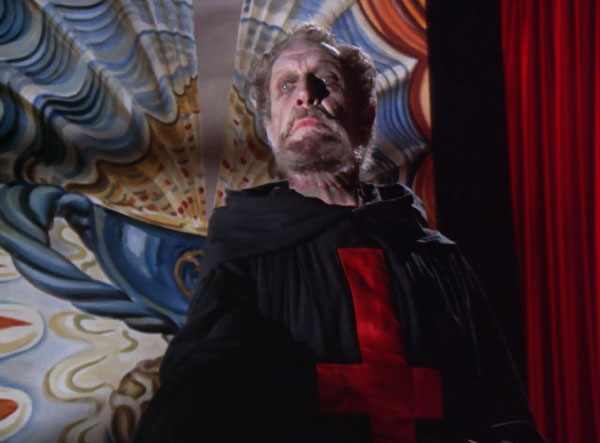
EPISODE 1: “The Return of the Sorcerer” (dir. Jeannot Szwarc; written by Halsted Welles, based on a short story by Clark Ashton Smith)
Bill Bixby is a young translator hired by Vincent Price, living in a large and creepy estate, of course, to tackle some as-yet-untranslated paragraphs from the ancient Necronomicon (another nod in the series’ love for H.P. Lovecraft). The job has frightened away two scholars so far, but Bixby, a non-believer in occult practices, has little to stop him from whatever he might find. Bixby plays the part in a near Itzak Stern (Schindler’s List) sort of fashion, as if his steady, even nerdy approach to the part can bring a certain verisimilitude to the episode’s outlandish elements (like the goat that Price and his lovely assistant, played by Patricia Sterling, like to join them at a place setting during meals), but his tone/acting style is not consistent with the manner of outright fun that the premise and Price’s performance bake into the center of the action. It’s broad, E.C. comics, comeuppance-themed fun for Price, who’s actually afeared of the curse that has brought his twin brother back from the dead – Price has chopped him into bits, and the pieces are individually rising up against him. The curse that Bixby’s translation adds to the mix, and what has frightened his predecessors away, is that anyone who translates and announces the curse will himself be chopped into bits. There’s some thinly tempting promise of a quick go with Bixby and Sterling, but it goes nowhere. But no matter, the consummation we really want is between Price and the devilish horror awaiting him by the hand of his re-membered brother, and the episode leaves us with a wobbly but fun promise of the demented fun ahead.
***
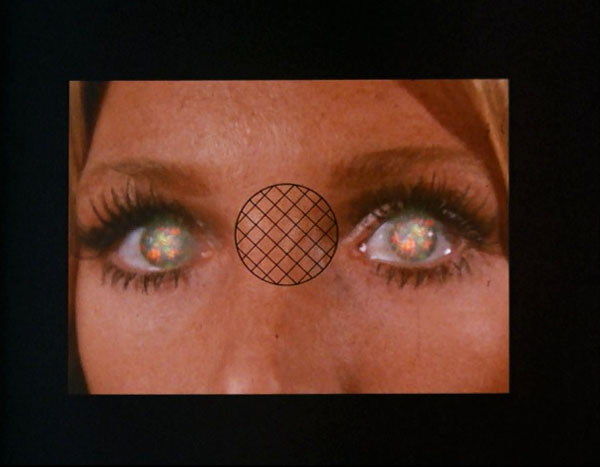
EPISODE 2: “The Girl With the Hungry Eyes” (dir. John Badham; written by Robert Malcolm Young, based on a dshort story by Fritz Leiber)
We’re with a fashion photographer named Faulkner (James Farentino), in the clear mode of a David Hemmings/Blow-Up situation, but small time, with small clients, until a mysterious woman (Joanna Pettet) appears in his studio who quickly claims all his attention. Young, beautiful, strong, preternaturally photogenic, she helps him land a choice gig with the Munsch Brewing Company with her as their “it” girl, Miss Munsch. But who is she? She has no home, no name, no portfolio, per se – it’s as if she’s sprung from Faulkner’s own concept of the perfect woman. But she has plans. It seems her eyes are the lure for men everywhere who seek power, wealth, immortality, and when she gets them close enough, she sucks the life right out of them. The story plays as a variation on the vampire story, or perhaps the siren in the shape of beautiful things that lure men to their death, but the entire conception in this case, with these trappings, can only smell of utter misogyny when the climax has Faulkner blaming her for all the evil that men do in the world. She’s ultimately the incarnation of every lustful thought that men have had, and is the effigy (literally burned to death in the end) that man must have to cleanse themselves of the guilt they all share for the brutal treatment of women everywhere. This tale may have begun as a rightful commentary on the swinging excesses of the ‘60s and burgeoning ‘70s, but plays now as a wrongheaded shifting of blame to the victim. Counter to the previous entry, this episode leaves us with a promise of heavy, moralistic speechifying in episodes to come.
***
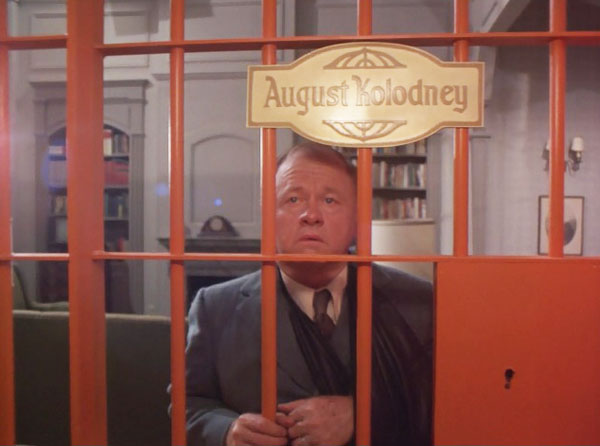
EPISODE 3: “Rare Objects” (dir. Jeannot Szwarc; written by Rod Serling)
We wallow in ten minutes of the time-worn cliches of the gangster genre, with Mickey Rooney as a beleaguered racketeer on the run from his many enemies and his own notorious fame, getting shot at while eating linguini at an Italian restaurant, employing a mob doctor to patch up his wounds, etc. But Rooney brings a real fatigue to the part, surely born at least partially from the previous couple of decades of wandering the TV/B-movie route toward oblivion. But when that mob doctor passes him the name and residence of someone who can help him escape the nightmare of his own making, and Rooney takes him up on it, he instead finds himself quite literally incarcerated inside the maxim “be careful what you wish for.” Raymond Massey’s whimsically erudite collector offers Rooney a chance at eternal health, at the price of everything he owns. Rooney barely has a chance to think before he finds himself in a collected menagerie of famous “missing” persons like Amelia Earhart and… Hitler. What keeps the front half going is watching Rooney lean into the anger and bitterness we feel must be true to his own life (a la his wrenchingly broad but utterly watchable Twilight Zone episode “Last Night of a Jockey”), while the back half is thoroughly sustained by Massey’s ebullient air of smiling normalcy, even after the reveal of his dark hobby. Both men are having fun with the story, in their own ways. As for Serling’s story, it’s reminiscent of a fine and comfortable old Twilight Zone episode, complete with its final twist of quasi-supernatural justice, rather than the usual outright horror of Night Gallery.
***
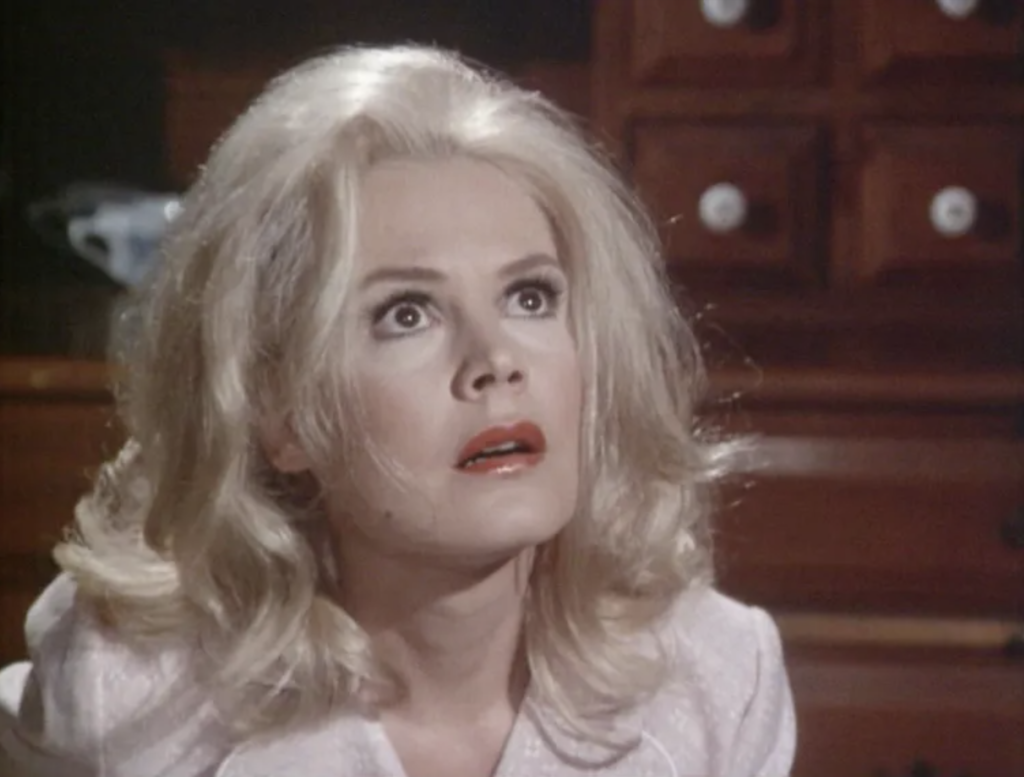
EPISODE 4: “Spectre in Tap-Shoes” (dir. Jeannot Szwarc, written by Gene Kearney)
Sandra Dee plays Millicent, who finds her twin sister, Marion, has hung herself in the upstairs attic-room. As a sort of dread follows her around the house, with the sound of Marion’s tap-dancing still filling the corridors at night, Millicent begins to descend into a state her friends and doctors all assume is madness. First, it’s about the guilt she feels for not being there when her sister needed her the most – but then panic, as she claims the rumpled clothing and burning cigarettes lying about the house were not put there by her but her sister. Her family moves from head-patting concern to fear for her sanity when she actually picks up smoking herself, and takes on her sister’s brash, commanding persona. Ultimately, we have a nice little ghost story that becomes a twist on Gaslight with some committed acting by Dee. It’s not the best ghost story this season, but it’s absolutely not the worst either.
***
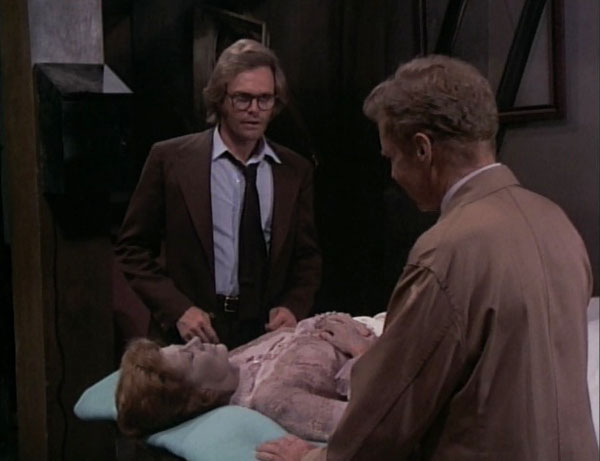
EPISODE 5: “You Can Come Up Now, Mrs. Millikan” (dir. John Badham; written by Rod Serling, based on a short story by J. Wesley Rosenquist)
In a nice bit of stunt casting, Ozzie and Harriet Nelson play Henry, a hapless, unsuccessful scientist/inventor, and his wife Helena, absent-minded to the point of ruining many of his attempts at scientific immortality. The episode plays off of their gentle, head-patting sweetness toward each other, the kind of dynamic familiar to viewers of their long-running TV show, but descends into the macabre rather quickly when he fills her with poison – in order to bring her back with his latest life-restoring antidote. He waits and waits… but no Helena. Burning with regret and sorrow at his latest failure – or is it hers? – he goes upstairs and kills himself, only for Helena to come up from the experiment vault as the mildest, most accommodating zombie ever. It’s predictable in the extreme, and one wants Serling to do more with it – perhaps to relish more in the classical Romeo & Juliet-ness of it all. Maybe something is gained by the contemporary audience getting to see a stalwart American television mom made up as a walking corpse. In any case, not one of Serling’s master works – more akin to one of Jack Laird’s one-joke “blackouts” writ too long. It’s not lost on this writer that the episode is capped with one of the only two blackouts of the season, “Smile, Please” (written and directed by Laird), a one-minute story of a woman trying to photograph a vampire that goes on for exactly one minute too long, but just long enough to drive a stake into whatever creepy good will Serling’s story generated.
***
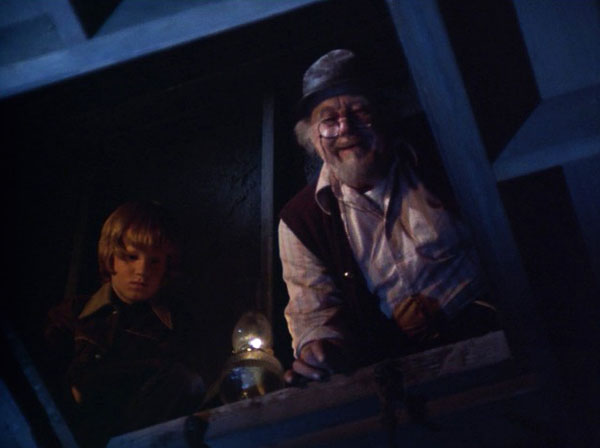
EPISODE 6: “The Other Way Out” (dir./writer Gene Kearney)
The jig is up for businessman Bradley Meredith (Ross Martin) after he’s killed a go-go dancer and a mysterious stranger begins sending him a series of cryptic commands that includes bringing a suitcase of cash to a specified location up a desolate mountain. On the way up, panicked Bradley wrecks his car and ends up inside a near-deserted old mansion – but it’s all been a ruse… The only person there is the girl’s father (Burl Ives), and he’s rigged it so Meredith would arrive there. Once ensnared, Meredith should know that he’s now a permanent resident. They’ll keep him there until he’s dead of starvation, or by “the other way out”: a gun and a single bullet. This is really a variation on the similar, season two episode “A Question of Fear” with Leslie Nielsen as a mercenary trapped in a “haunted house” as punishment for torturing and killing the owner’s father during the war. That one was more precise, focused, and driven by dialogue that centered the story on revenge. This one develops as haphazardly as a prototype Texas Chainsaw Massacre, but not in a good way. Ives is effectively creepy, with a soft-spoken edge of potential danger that pumps up the macabre ending, while Ross’s flailing victim is mostly just sustained reaction. Mostly, the episode is more evidence the series should have been called Rod Serling’s Comeuppance.
***
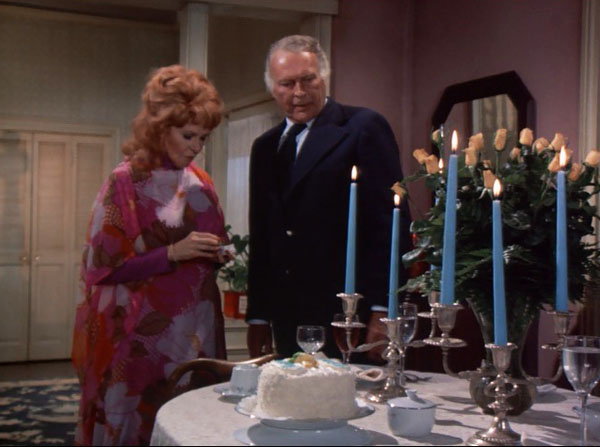
EPISODE 11: “Something in the Woodwork” (dir. Edward M. Abroms; written by Rod Serling, based on a short story by R. Chetwynd-Hayes)
Serling’s final produced script for television during his lifetime could not have been a proud moment for him. The story of a divorced woman (Geraldine Page) manipulating a ghost in the attic to scare her ex-husband (Leif Erickson) to death has the patina of something fetched from the bottom of the drawer. The performances are good but standard for the format – she’s somewhat broad, but imminently watchable, and the direction by Abroms is by the book, lending nothing new or surprising to the old-hat premise. Worse news is that the writing itself has none of the truest iteration of what we know Serling can bring to a small, scary story. Besides that, there is the problem of this being the third story out of the first eleven of the season that deals directly with a spectre in the attic, giving the show that special feeling of riding on fumes to the end. The other two are the aforementioned “Spectre in Tap-Shoes” and EPISODE 7 “Fright Night” (dir. Jeff Corey; written by Robert Malcolm Young), about a married couple in a new cabin dealing with a relative’s dead ghost in the man’s upstairs writing nook. The episode is a fair enough ghost story, with requisite mutual distrust looming and vows on the line, but it points toward nothing but itself and its hopes of spooking you – with dubious results. Adjacent to this litany is EPISODE 9 “She’ll Be Company For You” (dir. Gerald Finnerman; written by David Rayfiel, based on a short stroy by Andrea Newman), one of the more preposterous iterations, a kind of variation on season two’s “A Fear of Spiders”, this one featuring recent widower Leonard Nimoy being haunted by his wife’s ghost in the form of several man-eating cats in his home, all in retribution for his wandering eye during their marriage. Nimoy’s commitment to his growing guilt-mania notwithstanding, the effect is ultimately shrill and fast-forward inducing.
***
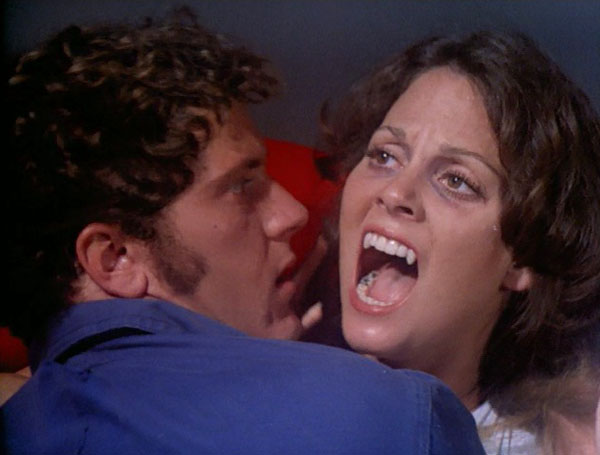
EPISODE 12: “Death on a Barge” (dir. Leonard Nimoy; written by Halstead Welles, based on a short story by Everil Worrell)
A surprisingly solid variation on the vampire story, young dock worker Ron (Robert Pratt) stumbles on an isolated barge and promptly falls in love with the siren-like waif, Hyacinth (Lesley Ann Warren) who slouches suggestively along its perimeter. She says she can’t allow him aboard, but also can’t traverse the water to reach him. She’s a vampire, and her father, also somewhere aboard the floating prison, would never allow their union. What follows has all the troubling demerits that typically haunt these cheaply made stories, most egregiously in this case a surplus of day-for-night photography that threatens to strangle it in chintzy 1970s gauze, until its persistence almost reconstitutes it as a strength, lending certain scenes a drunken, nightmarish atmosphere. Some of this might be kind forgiveness born from the ultimate mood of the piece, which draws the two central performances into a kind of prime time aria of actual lust and desire. Their final meeting, at last embracing, produces the only kiss all season that looks like real, pulsing attraction. Too bad it’s cut short by dad’s harpoon-like stake to Hyacinth’s bleeding heart. Leonard Nimoy’s directing debut is one of the better entries in the season, but it didn’t exactly put him in the rotation. He’d have to trade in the pointy teeth for those pointy ears awhile longer…
***
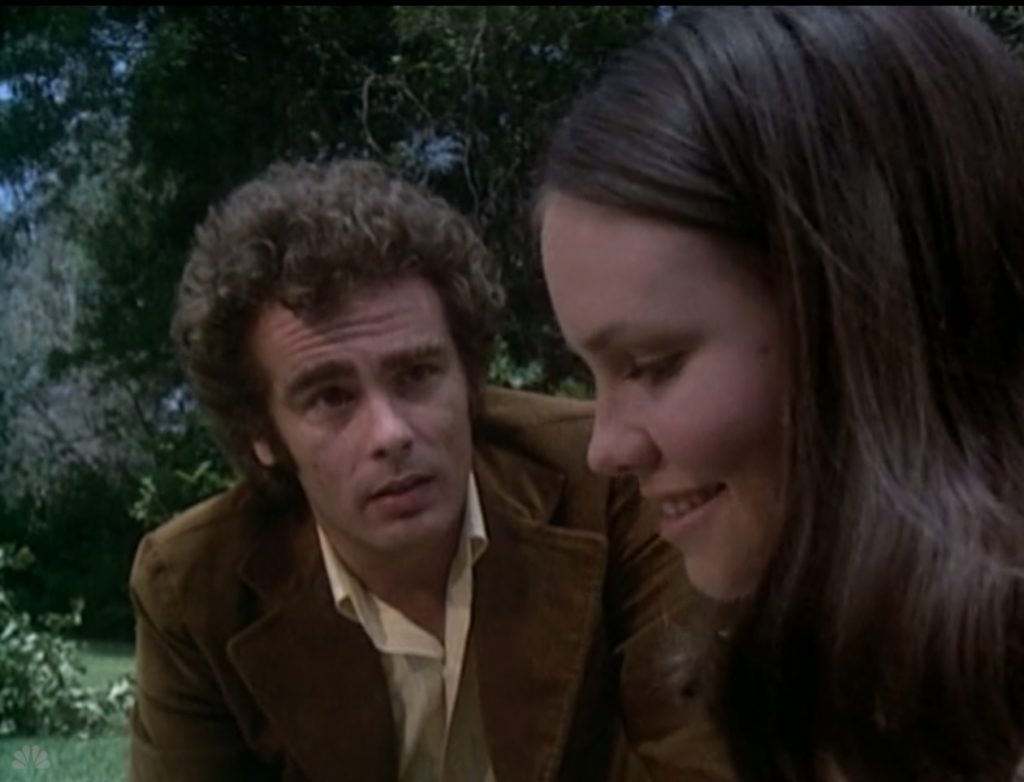
EPISODE 13: “Whisper” (dir. Jeannot Szwarc; written by David Rayfiel, based on a short story by Martin Waddell)
One of the more genuinely chancy, effective episodes of the season, possibly of the series. The fully-committed Dean Stockwell has brought his young wife, Irene – Sally Field, equally in thrall to her own role – from San Francisco to a small southern town to allow her wandering “vacancy” to find peace on her own accord – the doctors say she needs medication, but he just wants her to be free, and to finally be herself again. The episode is filled with elements that challenge even the most creative of this or any other season’s episodes, with verbal non-sequiturs that leave the viewer fully unmoored from the show’s usual predictability; bizarre, gothic-adjacent forays into psychological histrionics; and, even more unexplained, Stockwell breaking the fourth wall to address the camera as some unwelcome guiding force in Irene’s struggles, as if we, the viewer, are complicit in her melancholy madness. The overall effect of the episode is that of a waking nightmare, not of the bloody or macabre kind, but of a mournful journey into the subconscious.
***
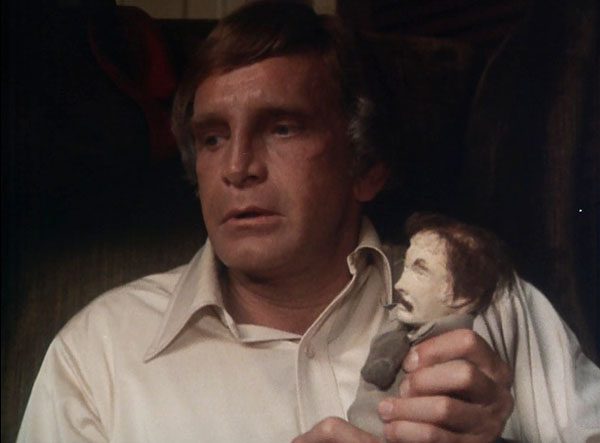
EPISODE 14: “The Doll of Death” (dir. John Badham; written by Jack Guss, based on a short story by Vivian Meik)
There’s a kinship between this tale of voodoo-backed comeuppance and the Serling-penned season two episode “The Caterpillar”. Both rely on cheating men to power their narratives, both take place in British colonial settings, and both feature retribution via old wives tales writ serious. Here a plantation owner (Murray Matheson) in the British West Indies has his bride (Susan Strasberg) stolen right out from under him, shall we say, by the bride’s ex-lover Raphael, played by always open-shirted Alejandro Rey. To exact his revenge, Matheson applies strategic pokes and squeezes to a voodoo effigy of the virile usurper until he’s on his death bed. A turnabout that transcends common sense, even in these sorts of story environs, shifts the ultimate pain of death onto the cuckold, which kind of seems unfair in the grand scheme of things. Bottom line is, it’s a fool’s errand to try and top the earwig-induced screams of Laurence Harvey in “The Caterpillar”.
***
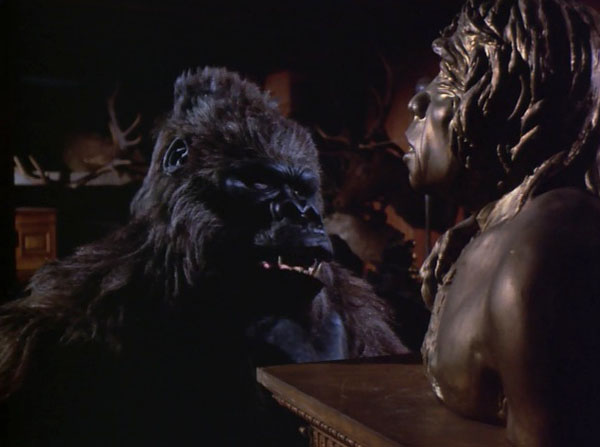
EPISODE 15: “Hate Unto Death” (dir. Gerald Finnerman; written by Halstead Welles)
A low point to end the series. What may have seemed heady, even daring on paper, with all its talk of evolutionary memory and primal antagonism, is rendered mockable when the central character is obviously a man in a gorilla suit. Finnerman, et al, are not up to the task of making us believe that millions of years of evolution tie this faux gorilla with the anthropologist (Stephen Forrest) who captured him, and that some ancient battle between the two is being teed up for a rematch inside a low-rent warehouse in 1973. We also meet Forrest’s big game cohort and wife (Dina Merrill), who’s against the beast’s incarceration, leading to lines like “That miserable gorilla is breaking up our marriage.” It’s then we know we’re in quality free fall. While this episode languishes in the collective memory – much akin to the thudding end of The Twilight Zone with “The Bewitchin’ Pool” – the world would have to wait seven years for Paddy Chayefsky to wrangle the same essential idea into a greater work of gonzo anthropology and blood memory in Altered States (1980). As if not reflecting the worst of the entire series already, the episode is the other of the two that end on a Laird “blackout”, this one so wretched a misfire, built on a flimsy pun so groan-worthy as to leave a blot upon even the best of the series.
***
Whatever you may think of season three, or of the series in complete, Kino Lorber shows its love in this two-disc package. Like the season two Kino Lorber outing, we’re overwhelmed by commentaries – every episode has at least one, most have two. Spread across the list of titles are the author/historian team of Scott Skelton and Jim Benson, filmmaker Guillermo del Toro, film historians Tim Lucas, Amanda Reyes, Craig Beam, and several others. Beam also showcases the third part of his featurette “The Syndication Conundrum”, breaking down the many ways the series was mishandled over the decades in the gauntlet of syndication. Anyone looking to understand the many ways this often-forgotten show sometimes epitomized, sometimes obliterated, audience expectations for horror and chills, there’s no other place to get it all but this set, and the other two seasons-worth, all offered by Kino Lorber Studio Classics. Serling may have ultimately wanted to forget it all happened, but the glimmering few genuine highlights from the series make that an impossibility. The show may limp to the end, but it haunts forever.


